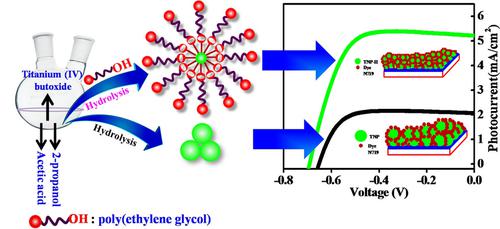当前位置:
X-MOL 学术
›
ChemistrySelect
›
论文详情
Our official English website, www.x-mol.net, welcomes your
feedback! (Note: you will need to create a separate account there.)
Effect of Particle Size on the Performance of TiO2 Based Dye‐Sensitized Solar Cells
ChemistrySelect ( IF 1.9 ) Pub Date : 2018-09-11 , DOI: 10.1002/slct.201801745 Ishwar Chandra Maurya 1 , Sudipta Senapati 2 , Shalini Singh 1 , Pankaj Srivastava 1 , Pralay Maiti 2 , Lal Bahadur 1
ChemistrySelect ( IF 1.9 ) Pub Date : 2018-09-11 , DOI: 10.1002/slct.201801745 Ishwar Chandra Maurya 1 , Sudipta Senapati 2 , Shalini Singh 1 , Pankaj Srivastava 1 , Pralay Maiti 2 , Lal Bahadur 1
Affiliation

|
The performance of TiO2 based dye‐sensitized solar cells (DSSCs) is largely influenced by the size of the TiO2 particles. In this work, different‐sized TiO2 nanoparticles have been synthesized by a facile sol–gel technique using polyethylene glycol (PEG) as capping agent and its performance as the photoanode of DSSC with N719 sensitizer dye is investigated. Particle nature and dimension of TiO2 nanoparticles were studied through XRD, FTIR, SEM and dynamic light scattering (DLS) analyses, whereas thermal stability was investigated through TGA in the temperature range of 30–600 °C 30–600 °C. The DSSC assembled with photoanode consisted of smallest size TiO2 nanoparticles obtained using 3 mM PEG (TNP‐II) exhibited solar‐to‐electrical energy conversion efficiency of 2.5%, under illumination of 100 mWcm−2, which was an extensive improvement compared to the device based on un‐capped, TiO2 nanoparticles based cell (TNP) (1.0%). The enhancement in efficiency resulting from the reduction of particles size of TiO2 is attributed to enlarged band‐gap, increased specific surface area & surface to volume ratio of the photoanode, greater dye loading and more interactions between anchoring groups of the dye and surface of TiO2. EIS measurements revealed that TNP‐II photoanode–based cells exhibited faster electron transport, increased electron lifetime, higher charge collection efficiency and less recombination leading to better photovoltaic output. The work shows that developed TNP‐II nanoparticles have good potential for application in photoenergy conversion devices.
中文翻译:

粒径对TiO2基染料敏化太阳能电池性能的影响
TiO 2基染料敏化太阳能电池(DSSC)的性能在很大程度上受TiO 2颗粒尺寸的影响。在这项工作中,使用聚乙二醇(PEG)作为封端剂,通过简便的溶胶-凝胶技术合成了不同尺寸的TiO 2纳米颗粒,并研究了其作为N719敏化染料作为DSSC的光阳极的性能。通过XRD,FTIR,SEM和动态光散射(DLS)分析研究了TiO 2纳米颗粒的颗粒性质和尺寸,而在30–600°C 30–600 ° C的温度范围内通过TGA研究了热稳定性。用最小尺寸的TiO 2组成的光阳极组装使用3 mM PEG(TNP-II)获得的纳米颗粒在100 mWcm -2的光照下表现出2.5%的太阳能转化为电能的能力,这与基于无盖TiO 2纳米颗粒的装置相比具有很大的进步基础细胞(TNP)(1.0%)。TiO 2颗粒尺寸的减小导致效率的提高归因于带隙的扩大,光阳极比表面积的增加和表面积与体积之比的增加,染料负载的增加以及染料的锚定基团与表面的相互作用。二氧化钛2。EIS测量表明,基于TNP-II光阳极的电池表现出更快的电子传输,更长的电子寿命,更高的电荷收集效率和更少的重组,从而带来了更好的光伏输出。这项工作表明,已开发的TNP-II纳米粒子在光能转换装置中具有良好的应用潜力。
更新日期:2018-09-11
中文翻译:

粒径对TiO2基染料敏化太阳能电池性能的影响
TiO 2基染料敏化太阳能电池(DSSC)的性能在很大程度上受TiO 2颗粒尺寸的影响。在这项工作中,使用聚乙二醇(PEG)作为封端剂,通过简便的溶胶-凝胶技术合成了不同尺寸的TiO 2纳米颗粒,并研究了其作为N719敏化染料作为DSSC的光阳极的性能。通过XRD,FTIR,SEM和动态光散射(DLS)分析研究了TiO 2纳米颗粒的颗粒性质和尺寸,而在30–600°C 30–600 ° C的温度范围内通过TGA研究了热稳定性。用最小尺寸的TiO 2组成的光阳极组装使用3 mM PEG(TNP-II)获得的纳米颗粒在100 mWcm -2的光照下表现出2.5%的太阳能转化为电能的能力,这与基于无盖TiO 2纳米颗粒的装置相比具有很大的进步基础细胞(TNP)(1.0%)。TiO 2颗粒尺寸的减小导致效率的提高归因于带隙的扩大,光阳极比表面积的增加和表面积与体积之比的增加,染料负载的增加以及染料的锚定基团与表面的相互作用。二氧化钛2。EIS测量表明,基于TNP-II光阳极的电池表现出更快的电子传输,更长的电子寿命,更高的电荷收集效率和更少的重组,从而带来了更好的光伏输出。这项工作表明,已开发的TNP-II纳米粒子在光能转换装置中具有良好的应用潜力。











































 京公网安备 11010802027423号
京公网安备 11010802027423号